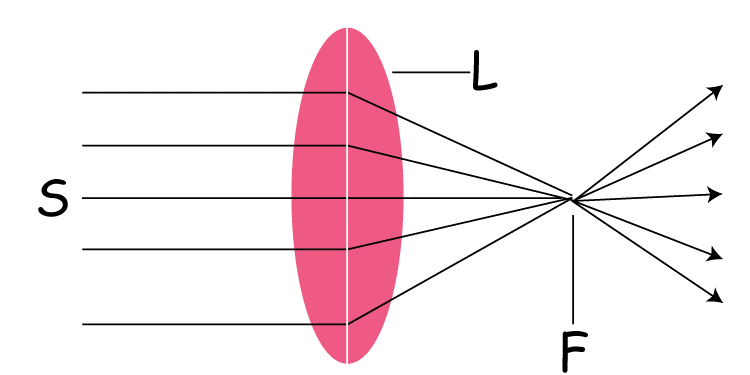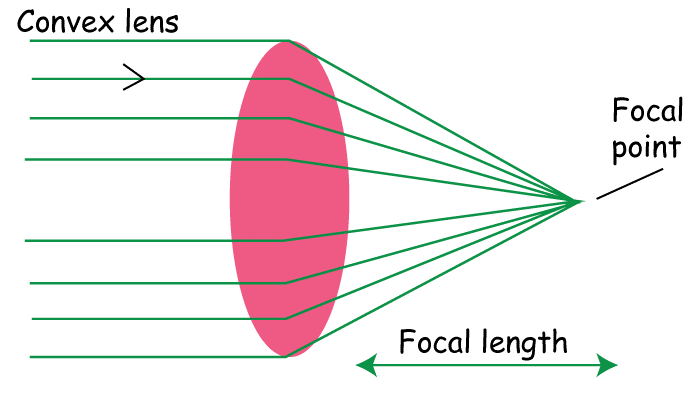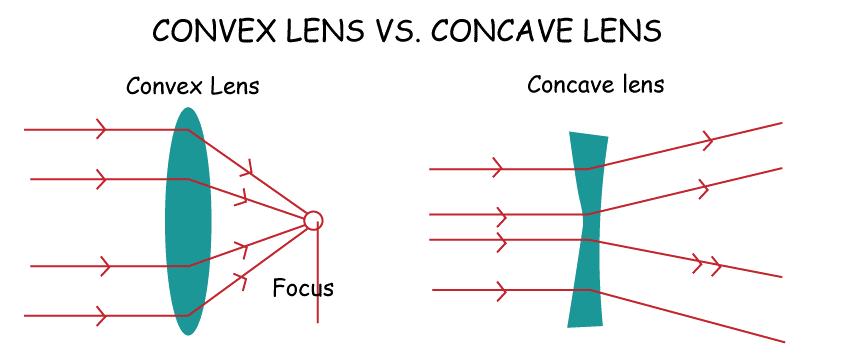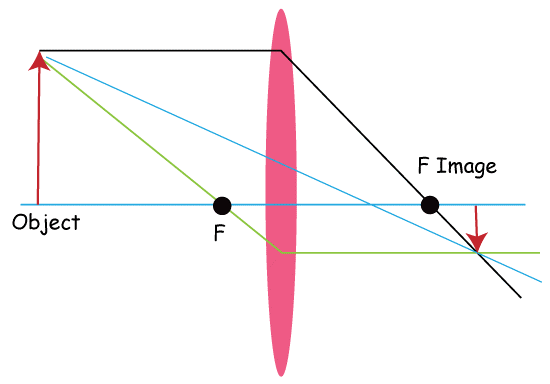Lens DefinitionLenses, used to focus, enlarge, or reduce an image, are essential to optical devices. Lenses are transparent objects constructed of glass or plastic with at least one curved surface refracting light. Lenses can concentrate or magnify light by causing light rays to bend or converge due to their curved surface(s). The lens's curvature and the substance it comprises, which has a refractive index, determine how much light is bent. The optical characteristics of a lens are determined by how it refracts light, which in turn depends on its shape. Numerous optical devices use lenses, such as cameras, microscopes, telescopes, projectors, and spectacles. 
Various Lens TypesThere are various lenses, each with particular visual characteristics and applications. The most common kinds of glasses are: Convex LensesConverging or convex lenses have a thicker centre and a thinner border. They cause light waves to refract inward towards a focal point. Cameras, binoculars, telescopes, and magnifying spectacles all use convex lenses. Concave LensesConcave or diverging lenses are thicker at the sides and thinner in the centre. They redirect light waves away from a focus point and outward. Concave lenses are used in optical instruments to generate a virtual image and in eyeglasses to correct near-sightedness. Zoom LensesBecause these lenses' focal lengths are variable, the user can alter the magnification without switching lenses. They are frequently utilized in optical devices like cameras and camcorders. Prime LensesPrime lenses, also fixed-focus lenses, are non-adjustable and have a set focal length. They frequently create sharp, high-quality images and are used in portrait photography. Telephoto LensesTelephoto lenses can magnify far-off objects because they have a greater focal length than standard lenses. They are frequently employed in wildlife, sports, and portrait photos. Wide-angle LensesWide-angle lenses can capture a broader field of view because they have a shorter focal length than standard lenses. They are frequently employed in photos of interiors, buildings, and landscapes. Macro LensesMacro lenses take close-up pictures of small items like jewellery, flowers, and insects because they have a high magnification ratio. Fisheye LensesThese have an incredibly wide field of vision and create spherical, distorted images. In artistic photos and videography, they are frequently employed. Convex LensesConvex lenses, or converging lenses, have thicker centres than their corners. They are frequently employed in optical devices to focus incoming light rays towards a focal point, producing an enlarged, good picture. Convex lenses curved surfaces, which cause light to distort or refract as it travels through the lens, give them their optical characteristics. Depending on the placement of the item and the observer, convex lenses can be used to create both actual and virtual images. When light rays collide at a specific location in space, a real picture is created that can be projected onto a surface or screen. When light rays appear to diverge from a spot behind the lens and cannot be projected onto a screen, a virtual image is created. Cameras, telescopes, binoculars, and magnifying spectacles frequently employ convex lenses. By refracting light to concentrate on the retina, they can also be used to treat some vision issues, such as farsightedness. 
Concave LensesConcave or diverging lenses have a thinner middle than the sides. They are frequently used in optical devices to diverge incoming light rays to create a smaller, virtual image. Concave lenses' curved surfaces, which cause light to distort or refract as it travels through the lens, give them their optical characteristics. In contrast to convex lenses, concave lenses consistently create virtual images that seem smaller than the observed object. This is because the light rays have diverged from a spot behind the lens. By diverging light to concentrate on the retina, concave lenses can also treat some vision issues, such as near-sightedness. 
Concave lenses are frequently used in contact lenses and eyeglasses to rectify vision issues. They also generate a virtual image of the observed object in optical instruments like telescopes and microscopes. Lens SpeedWhen referring to lenses with f/2.8 or larger maximum apertures, the word "fast" is frequently used. These lenses are frequently employed in sports and action photography and portrait, wedding, and event photos. It's essential to remember that lens speed is only one aspect to consider when selecting a lens. Additional elements like focal length, image stabilization, and optical quality can also influence the efficacy and adaptability of a lens. Depth of FieldThe distance range in a picture that appears to be in sharp focus is called depth of field (DOF). It is influenced by several variables, such as the aperture setting, the lens's focal length, and the camera's and the target's separation. A shallower depth of field results from a larger aperture opening (smaller f-stop number), which means that only a small part of the picture will be sharply in focus. This can blur the backdrop and isolate the subject from its surroundings. More of the picture, including the subject and the background, will be in sharp focus when the aperture opening is smaller (larger f-stop number). The lens's focal length also influences the depth of field. Generally speaking, telephoto lenses and other lengthier focal lengths have shallower depths of field than other shorter focal lengths. (e.g., wide-angle lenses). As a result, a longer lens will result in a blurrier background and sharper topic focus. Lens DistortionThe phenomenon of a lens bending light that makes straight lines appear curved or skewed in the final picture is known as lens distortion. It has several variations, including moustache, pincushion, and barrel distortion. Straight lines appear curved inwards away from the centre of the picture with pincushion distortion, while straight lines appear curved outwards towards the centre of the image with barrel distortion. Straight lines look curved in a wave-like pattern due to moustache distortion, a combination of barrel and pincushion distortion. Many things, including the lens's construction, focal length, and the separation between the camera and the target, can result in lens distortion. Wide-angle lenses are more prone to it, and shifting or tilting the lens, as with perspective control lenses, can worsen it. With the help of specialized lens correction software or post-processing tools like Adobe Photoshop or Lightroom, lens curvature can be fixed. Additionally, some cameras and lenses have built-in distortion correction capabilities that instantly fix distortion during the image process. It is important to remember that some shooters purposefully use lens distortion as a creative effect, especially in architectural or landscape photography. However, lens distortion can be corrected to enhance the end image's overall quality and accuracy for most photographic techniques. Lens CoatingsTo enhance a lens's functionality and image clarity, thin layers of material are applied to its surface. They can enhance the lens's ability to transmit light, lessen rays and flare, and lengthen its useful life. Anti-reflective coating is a typical form of lens coating that lessens reflections and glare brought on by light reflecting off the surface of the lens. This can enhance the image's contrast and sharpness, lowering unwanted reflections and artefacts. A scratch-resistant coating is another lens covering that can help shield the lens from scuffs and other harm. This is especially crucial for lenses used in challenging environments, like those found in outdoor or sports photos. Other lens coatings include UV coatings, which prevent harmful ultraviolet light and shield the lens and camera sensor from harm, as well as water and oil-repellent coatings, which aid in keeping liquids like water and other substances off the surface of the lens. Lens coatings can be used on various lenses, such as cameras, spectacles, and microscopes. The precise kind and mixture of coatings used on a lens will vary depending on the lens's intended use and performance specifications. Lens ElementsThe individual bits of glass that make up a camera lens are known as lens elements. To control how light passes through the lens and eventually hits the camera's sensor or film, these components are precisely shaped and placed inside the lens barrel. Most camera lenses have numerous elements to correct optical aberrations like distortion and chromatic and spherical aberration. Depending on the lens type, focal length, and aperture, a lens's design and amount of lens elements can differ significantly. There are numerous kinds of lens components, such as: 
Spherical ElementsSpherical elements are fundamental lens components that have a constant surface curve. They cannot rectify complex aberrations but can be used to correct some aberrations. Aspherical ElementsLens components known as aspherical elements have an irregular surface shape. They can aid in reducing distortion and enhancing sharpness and are used to correct more complicated aberrations. ED (Extra-low Dispersion) ElementsED (Extra-low Dispersion) elements are lens components made of special glass that reduce chromatic aberration. This optical aberration results in colour fringing in image areas with strong contrast. Fluorite ElementsFluorite elements are lens components made of a particular kind of crystalline substance that aids in lowering chromatic distortion and other optical aberrations. They are frequently found in expensive telescopic lenses. Apodization ElementsApodization elements are lens components that control how light is distributed across the image plane, producing a smoother and more aesthetically appealing bokeh. The combination and placement of these various lens element types within a lens can significantly affect its functionality, image clarity, and cost. High-end lenses frequently have cutting-edge optical designs that use a variety of lens elements to produce the best possible image clarity. Mounts and Suitability for LensesA lens attachment system fastens the lens to the camera body. Different camera companies employ various mounts that are incompatible with one another. For instance, Nikon cameras use the Nikon F mount, while Canon cameras use the Canon EF or EF-S frame. This means that without an adapter, a lens made for one camera brand cannot be placed on a lens made for a different camera brand. Several third-party lens makers create lenses with mounts compatible with various camera brands and brand-specific mounts. Tamron and Sigma produce lenses with mounts for Canon, Nikon, Sony, and other camera manufacturers. Even though a lens may have a compatible mount, it might be only partially compatible with some of that brand's camera models. For instance, some lenses may need to be fixed on a camera with an APS-C-sized sensor because they were created especially for full-frame cameras. Similarly, some lenses might work differently with more recent camera versions that include features like advanced autofocus systems. Before making a purchase, it's crucial to confirm that a lens is compatible with the particular model of your camera and to learn about any potential restrictions or issues. Using an adapter to mount a lens from a different manufacturer may also decrease performance or functionality, especially concerning autofocus and image stabilization. Lens AccessoriesA variety of accessories can be used to improve functionality and extend the capabilities of camera lenses. Here are a few typical lens add-ons: Lens HoodBy preventing stray light from penetrating the lens, a lens hood reduces lens flare and enhances contrast. It is a device that fastens to the front of the lens. FiltersTo change how light travels through the lens, thin pieces of glass or plastic are attached to the front of the lens. Polarizing filters, neutral density filters, and colour filters are examples of common filter kinds. 
Extension TubesThe lens can concentrate more closely on an object by attaching a hollow extension tube between the camera body and the lens. This can be helpful for macro photography and other circumstances requiring close-up concentration. Lens ConvertersLens converters can be affixed to lenses to modify their focal lengths or make them compatible with various camera mounts. Tripod CollarA tripod collar is a band that fastens to the lens and enables direct mounting of the lens to a tripod. When using heavy or lengthy lenses, this can assist in stabilizing the camera and lowering the chance of camera shake. Lens Cleaning PackageA lens cleaning package contains supplies for the lens, including a microfiber towel, lens cleaning solution, and a lens blower. Lens CapWhen the lens is not in use, a protective cover called a lens cap fastens to the front of the lens to shield it from harm like scuffs and dust. A lens's style, brand, and mount will determine the compatible accessories. Before making a purchase, it's crucial to confirm an accessory's compatibility with your equipment and thoroughly study the advantages and restrictions of every available accessory for your particular photography requirements. Picking Out the Ideal Lens for Your RequirementsSelecting the appropriate lens for your requirements is crucial to take outstanding pictures. The following elements should be taken into account when choosing a lens: Focal LengthThe focal length of a lens affects both the perspective and angle of view of the picture. Wide-angle lenses with shorter focal lengths have a larger field of view and are good for taking pictures of scenery, buildings, and natural settings. Using longer focal lengths (telephoto lenses) for portrait, wildlife, and sports photos is advantageous because they have a narrower field of view. ApertureA lens's aperture controls the depth of field and how much light reaches the camera. When there is little light, lenses with wider apertures (lower f-stop values) can produce shallow depths of field with blurred backgrounds. Image StabilizationWhen using slower shutter speeds or shooting handheld, image stabilization is particularly helpful in reducing camera shake. While some lenses have image stabilization built right in, others depend on the camera's in-body image stabilization. Lens SpeedA lens's greatest aperture and the speed at which it can focus are called its speed. Faster lenses help capture moving objects and low-light conditions.
Next TopicMilk Definition
|
 For Videos Join Our Youtube Channel: Join Now
For Videos Join Our Youtube Channel: Join Now
Feedback
- Send your Feedback to [email protected]
Help Others, Please Share










